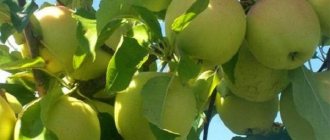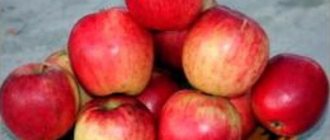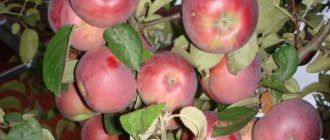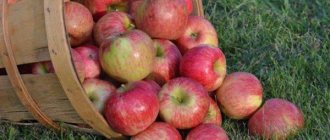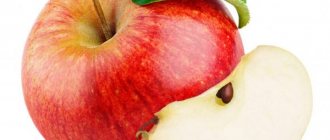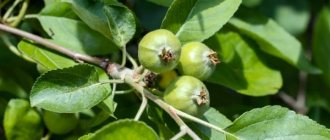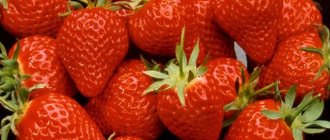Characteristics
Varietal characteristics of the Solntsedar apple tree:
- medium-sized tree;
- the crown is dense, prone to thickening;
- medium-sized leaves, shiny, with a noticeable bluish tint;
- skeletal branches extend from the trunk almost at right angles;
- the fruits are round, slightly ribbed, medium in size (weighing up to 150 g), very beautiful in color: green with a bright crimson blush, blurred over almost the entire surface.
Peculiarities
One of the features worth noting is the uneven ripening of fruits. Apples ripen in stages, resulting in the harvest being spread over several weeks.
Tree height
An adult tree is medium-sized, up to three meters in height. Low growth makes it easier to care for the apple tree, ensuring labor-intensive processing and harvesting.
Apple tree Solntsedar.
Crown width
In adulthood, the crown of the apple tree is rounded and slightly thickened. The crown width is about three meters. With age, the crown becomes slightly spreading and drooping.
Productivity
The productivity of a mature apple tree is high. On average, 90 kg of apples are harvested from one tree. As trees age, they begin to bear fruit periodically.
Tasting evaluation of fruits
The apple pulp is snow-white with red veins, juicy, has a good sweet and sour taste with a slightly tart aftertaste. On a five-point scale, the taste of Solntsedar deserves a rating of 4.3 points.
Winter hardiness
Thanks to the hardening carried out during the breeding work, Solntsedar has excellent winter hardiness and frost resistance. Even a young tree does not need shelter from the winter cold. These qualities make it possible to grow the cultivar in various regions with unfavorable weather conditions.
Disease resistance
Unfortunately, for all its advantages, the cultivar has one big drawback: low resistance to infection by scab of fruits and leaves. Regular treatment of apple trees with antifungal drugs will be required.
Lifespan
Considering the harsh climatic conditions for growing Solntsedar apple trees, the life expectancy of the tree corresponds to average indicators. The lifespan of an apple tree reaches 35 years, of which only half of the time is maximally productive.
Pros and cons of apple trees
Apples of this variety have a number of advantages:
- taste qualities;
- easily survives low temperatures;
- brings a large amount of harvest;
- tree size for easy maintenance.
But as with all other types, there are some drawbacks:
- inability to self-pollinate;
- susceptibility to many diseases;
- short shelf life of fruits;
- frequency of fruiting in adult crops.
See also
Description and characteristics of the Chudnoye apple tree, variety yield and cultivationRead
Features of planting and care
The cultivar is sun-loving and requires location in a well-lit area. But this is a non-drought-resistant crop, so regular watering is necessary in dry weather.
Landing rules
The rules for planting Solntsedar seedlings are no different from the rules for planting young trees of other varieties. Planting is carried out in a pre-prepared hole in compliance with all the requirements for proper planting of apple crops.
Planting a Solntsedar apple tree in a pre-prepared hole.
Deadlines
Considering that the variety was selected for cultivation in regions with cold winters, it is best to plant a seedling in open ground in a permanent place in the spring. In autumn, seedlings can be planted in regions with a mild climate.
Saplings with open root system
Purchasing seedlings with an open root system has several positive aspects:
- the cost of a seedling with ACS is lower than the cost of a seedling in a container;
- it is possible to make a preliminary assessment of the root system of a seedling immediately before purchase, which eliminates the purchase of a seedling with a poorly developed or damaged root system;
- high survival rate of young growth, the likelihood of getting healthier and stronger trees in the future.
Green cuttings
Vegetative propagation of apple trees using green cuttings will allow you to renew old trees or propagate your favorite variety without spending a lot of money from the family budget.
The easiest way to take green cuttings is to root the cuttings in a jar of water. To do this, cut last year's green shoots 20 cm long with three buds.
The chopped shoots are placed in water, root formation stimulants are added to it and left for several weeks, periodically adding water to the container. When the roots grow 7 cm long, the seedlings are planted in the ground.
Seedling survival rate and growing features
Purchased seedlings with an open root system or seedlings obtained by cuttings have the best survival rate. The successful survival of young animals directly depends on the correct location for planting. Sufficient lighting, fertile soil, and absence of stagnant moisture are the guarantees of a positive result.
Apple tree seedlings Solntsedar.
Agricultural technology
Solntsedar does not require special care or much attention. But simply planting an apple tree and “forgetting” about it until harvesting is not possible. Basic agrotechnical measures will still have to be observed:
- Regular vegetative and moisture-recharging watering is required. During dry seasons, the frequency of watering increases;
- regular application of complex mineral supplements is encouraged;
- special attention needs to be paid to the prevention of fungal infections;
- the tendency to thicken the crown requires little intervention from the gardener - periodic pruning of branches is recommended.
Pruning and crown formation
Apple trees are pruned in order to form a comfortable, productive crown and prevent fungus. Pruning is done in the spring, before active sap flow begins, or in the fall, after leaf fall.
Spring pruning has the function of forming the crown. All unnecessary branches that thicken the crown and interfere with the development of the main branches are cut off. Autumn pruning is sanitary - weak, dry branches are removed.
Formation in the form of a bush
Some experienced gardeners grow Solntsedar in the form of a bush rather than a tree. This effect is achieved by the following measures:
- When planting an annual seedling in a permanent place, radical pruning is immediately performed: the central conductor is shortened to 20 cm in height, leaving the three most developed lateral shoots and shortening them by 2-3 buds.
- Every year, two more branches are added to the main branches, which are shortened by 3 buds. Secondary branches are cut to 15-20 cm.
- Annual formation is carried out until the bush reaches a height of two meters: six skeletal branches are left, the central conductor is cut off next to the upper skeletal branch.
Pollinator varieties
Sunflower is self-fertile and requires cross-pollinators. The varieties that perform this role best are Bely Naliv, Suislepskoe, Vinnoe or any other variety with similar flowering periods.
Seasonal care for young apple trees
Follow-up care for young apple trees:
- Watering of young trees is carried out 3-4 times per season. During hot weather, the amount of watering needs to be increased.
- In early spring, before the buds swell, fertilizing is carried out using mineral and organic fertilizers. Moreover, during this period it is necessary to give nitrogen-containing preparations, such as dry bird droppings, bone meal, “Carbamide”, etc. In the fall, fertilize with complex products with a predominant content of phosphorus and potassium, which include potassium sulfate, potassium salt, superphosphate, phosphate rock. All drugs are used strictly following the instructions supplied with them.
- Crown formation consists of sanitary and formative pruning, for which you need to use garden tools that have been previously sharpened and disinfected (hand saw, pruning shears, garden knife, etc.). During formative pruning, in the first year after planting, the height of the trunk is determined (approximately 50 cm). From this level you need to measure another 30 cm, setting the height of the crown, and lay the lower tier of skeletal branches. Next year, leave two branches with opposite growth in the lower tier. The upper branches at a distance of at least 15 cm should be shorter than the lower ones so as not to block the sun or overhang. In the third year, trim skeletal branches at a distance of 50 cm from the trunk. In the fourth year of the plant’s life, form another, upper and final, tier of branches. In subsequent years, do not change the shape of the crown, but simply shorten and thin out a little. Sanitary pruning is carried out annually to remove dry, damaged and diseased branches.
- Pest prevention and control involves whitewashing tree trunks with lime. Although infection with fruit rot and milky shine is possible. Against these diseases, you can use the drug “Skor” (2 ml per 10 liters of water), “Tsiram” (50 g per 10 liters of water). The most common pests are: aphids, copperheads, mites, leaf rollers, from which Fitosporin (5 g per 10 liters of water), Trichodermin (20 g per 5 liters of water), Iskra double effect (1 tablet per 10 l water).
- It is regularly necessary to loosen the tree trunk area to supply the root system with oxygen, remove weeds and other debris, and mulch.
The VEM-Pink apple tree has taken pride of place in regions where winters last long and summers are short, thanks to the characteristic features instilled in it, which include: high frost resistance, immunity to scab, rapid ripening and long storage of fruits, ease of cultivation and good taste of ripe fruits. apples
Ripening and fruiting
An early summer ripening variety - already in early August there is an opportunity to taste the first apples. Every year, starting from the first harvest, fruiting is stable without periods of rest. With the onset of age of extinction (approximately 20-25 years), the yield decreases, and fruiting becomes periodic.
Solntsedar apple tree harvest.
Beginning of fruiting
The first fruits are harvested from the Solntsedar apple seedling at the age of 4-5 years. The first economically useful abundant harvest will be obtained from a seven-year-old tree.
Flowering period
Solntsedar blooms in mid-May, flowering lasts about two weeks. The flowers are quite large, white with a pinkish tint. During flowering, the tree looks very elegant.
Deadlines
Apples reach maximum consumer ripeness almost simultaneously with harvesting ripeness, so they can be eaten straight from the tree.
Maturation stage
A characteristic feature of Solntsedar is the non-simultaneous ripening of fruits: apples ripen in stages. At the same time, ripe fruits tend to crumble almost immediately. This feature causes some inconvenience during harvesting, because you have to harvest apples from one tree several times.
Storage and collection of fruits
Apples are picked by hand, removing them from the branches along with the stalks in dry weather. Apples can be stored in the refrigerator for up to two months, or at room temperature for a couple of weeks. It is recommended to store fruits in wooden boxes: apples do not “suffocate” in them.
Solntsedar apples withstand transportation. The dense skin can withstand light impacts of fruits against each other during transportation and does not crack or bulge.
Description of the variety Seedling Solntsedara
The crown of the apple tree is attractive to the most sophisticated eye: spreading, thick, wide.
The trunk and branches are brown, medium height. From an aesthetic point of view, this variety is an excellent choice for a summer garden, and it does not require special care.
Ruddy round fruits scattered on the branches are good. Smooth, neat shape, medium size, with a yellow-red skin and a shiny waxy coating. The flesh of the apples is light white with thick red veins.
The taste of apples is in no way inferior to their appearance: sour, aromatic and juicy. A characteristic highlight is some tartness and a wine-sweet aftertaste. Thanks to the breeders for such a find.
Subspecies and options
In addition to the usual vegetation form, the variety is grown in bush or slate form.
Seedling
A one-year-old seedling obtained from seeds is often formed into a bush. This form is convenient for harvesting, caring for and processing wood.
One-year-old seedlings of the Solntsedar apple tree.
Creeping view
Slate types of apple trees are formed using a specially developed technique. This method protects trees from severe frosts and frost damage. The photo below shows the slate form of an apple tree.
Slate form of the Solntsedar apple tree.
Diseases and pests
Despite many positive qualities, this apple tree, unfortunately, cannot boast of significant resistance to the main diseases that affect these trees - scab, fruit rot, milky shine and powdery mildew. These diseases can be prevented if, in the spring, before the buds open, the tree is sprayed with a solution of copper sulfate.
Of the pests, the most dangerous for the Solntsedar apple tree are aphids, caterpillars and spider mites. The best methods of controlling these pests are timely whitewashing of the tree trunk, as well as treatment with a solution of some insecticide, for example, Bordeaux mixture.
Apple trees have poor resistance to fungal diseases. The level of resistance of fruits and leaves to scab is very low. Basic measures to combat fungal diseases:
- Scab. The most dangerous disease. To combat it, you need to treat the tree with a urea solution.
- Powdery mildew. To defeat this disease, you need to spray the apple tree with a solution of colloidal sulfur.
- Fruit rot. The main measure to prevent the spread is the destruction of damaged fruits.
- Milky shine. In order to destroy the causative agent of this disease, you need to spray the apple tree with a solution of soda ash.
https://www.youtube.com/watch?v=MDMDU8QbaGk
Apple trees of the Solntsedar variety are widespread in households.
Many gardeners have chosen this particular variety for cultivation due to its early ripening period and excellent taste of the fruit.
Unfortunately, one of the disadvantages of this variety is the short shelf life of the fruit. But even in the form of canning, apples will delight you for many months.
The disadvantage of the variety is its lack of resistance to diseases. Apple trees can suffer from:
- scab. Prevention from the disease is to treat trees before flowering with a 1% solution of Bordeaux mixture (take 100 g of copper sulfate and 150 g of lime per 10 liters of water). When the first signs of the disease appear, the drugs Hom or Abiga-pak are used;
- powdery mildew, which can be avoided by spring preventative treatment of apple trees with colloidal sulfur or 1% Bordeaux mixture. If symptoms appear, fungicides Topaz or Topsin will help;
- fruit rot, from which the drugs Fitosporin, Fitodoctor, Bordeaux mixture, Fundazol, Horus and others will save you;
- milky shine, which can even lead to the death of the tree if it is not dealt with. Diseased branches must be removed, and wounds on the bark must be cleaned and covered with garden varnish. As a preventative measure in the spring, apple trees can be sprayed with an aqueous solution of soda ash.
Apple trees of the Solntsedar variety can also be attacked by insect pests:
- aphids;
- leaf rollers;
- apple blossom beetle;
- apple moth.
Treating apple trees with an aqueous solution of wood ash with the addition of laundry soap (per 10 liters of water - 1.5 kg of ash and 50 g of soap) will protect against aphids.
The most significant disadvantage of the variety is its instability to scab. The scab pathogen Venturia inaequalis infects both opening buds and mature fruits during the wet period.
This is why preventive measures are so important.
To avoid infection, it is necessary to spray trees with biofungicides during the growing season. You can repeat the procedure after, in the flowering and fruiting phase.
Good results are obtained by three-time treatment with immunocytophyte, which activates the plant’s natural defense mechanisms.
In autumn, it is important to burn fallen leaves; trees can be sprayed with solutions of urea 7% or ammonium nitrate.
But don’t be afraid of difficulties, they can be overcome.
The Solntsedar seedling will not cause much trouble for the gardener.
With its generous harvest, exceptional beauty, and winter hardiness, it has already won love and recognition. This variety is included in the honorary list of breeding achievements of the Volga-Vyatka and Ural regions. Undoubtedly, this is just the beginning. The Solntsedar seedling will adequately decorate your garden plot, you just have to try it.
If you find an error, please highlight a piece of text and press Ctrl Enter.
Growing in regions
The variety is recommended for cultivation in the Volga-Vyatka and Ural regions. Territories with a continental climate, characterized by consistently frosty winters and hot summers with little precipitation, are most suitable for Solntsedar.
In the Moscow region and Leningrad region
Excellent frost resistance allows apple trees of the Solntsedar variety to feel quite at ease in the Moscow and Leningrad regions. The only thing a gardener will have to pay attention to when growing this variety is its susceptibility to fungal infections.
In the Urals
The variety was selected in the Urals specifically for cultivation in local conditions, so in a particular region Solntsedar is the master.
In Altai and Western Siberia
Due to the severe winter frosts of Western Siberia in the above-mentioned region, it is recommended to grow an apple tree in a stylized form, or to carefully cover the tree for the winter.
Region of natural distribution
In nature, this variety is widespread in the Urals, but thanks to its frost resistance, it adapts well to colder climates. The preferred climate for the Solntsedar variety is a continental climate. But the variety will feel best in regions with warm summers and long autumns.
When adapting a variety to severe drought conditions, it needs to be provided with abundant watering.
Apple trees absorb nutrients in dissolved form through the root system
Therefore, it is very important to provide the tree with regular watering in dry conditions. This is necessary so that the tree can accumulate the necessary amount of microelements for the normal process of photosynthesis.
When growing a variety in extreme cold conditions, regular fertilizing is necessary. Frozen soils are usually poor in nutrients.
It is worth feeding a young tree 2 times a year. The most favorable months for these events will be spring and autumn.
As the tree ages and adapts, the amount of fertilizing can be reduced to 1 per year.
Reviews
Inna, Nizhny Novgorod region : “We really love making various preparations for the winter from apples. Solntsedar is completely satisfied as a supplier of high-quality raw materials for homemade preparations. And fresh apples “scatter” at once.”
Dimitry, Leningrad region : “Solntsedar has been growing here for a long time. Yes, he gets sick periodically. But we still try to prevent diseases rather than deal with the consequences... One day we didn’t have time to harvest the harvest - we arrived at the dacha, and the apples were already lying on the ground. We made jam from padanki, it turned out very tasty.”
Apple tree Solntsedar
With all its advantages, this variety of apples requires careful care, because it is highly susceptible to scab. And it has many advantages. Apples ripen early - already in mid-August they are completely ready for consumption in the Stavropol Territory. Almost every year, apple trees produce high yields - from 100 kg per tree. Externally, the fruits are very attractive, which contributes to high consumer demand for this variety. When fully ripe, the apples quickly crumble - this can be attributed to the disadvantages of this variety. If you miss time, then the entire harvest will be on the ground under the trees and you will have to completely let the apples go to juice - when they fall from the tree, they are severely damaged and begin to rot instantly. The trees are medium-sized, at the age of 8 years - 3 meters, easy to harvest. To combat scab, we treat trees in the fall and spring. We use a solution of colloidal sulfur, Bordeaux mixture and other similar preparations. We also regularly remove fallen leaves from the trees and dig up the soil - otherwise we won’t see a good harvest.
This variety of apples blooms here in mid-May, and in mid-August it already pleases with delicious, ripe apples. They are very elegant in appearance. Light cream color with pinkish-red bright sides. The stalks are short and, looking at the tree, one gets the impression that the apples lie on the branches and do not hang. They are not large in size, an apple weighs a maximum of 100 grams, but they bear fruit well. The first fruits appeared only 4 years after planting the seedlings. Now we collect 10 buckets from a tree. I just don’t recommend storing these apples. Even in the refrigerator at constant temperature and humidity, they can withstand 1.5 months. Therefore, we immediately put the entire harvest into processing. Since apples are juicy, they make excellent juice. We sell part of the harvest - smooth and beautiful apples are in good demand on the local market.
Description of the tree
The height of an adult tree of this variety rarely exceeds 3-4 meters, the crown has rounded outlines, is quite dense and thick, and droops to the ground over time. The main branches, moving away from the trunk, form an acute angle; the bark on them and the trunk has a brown tint. The bulk of the fruits are set on branches two to three years old.
Young branches are dark brown in color, quite thin, covered with a small amount of fluff, the internodes are quite short, the shape of the branches when cut is round.
The leaves are medium in size, elongated-ovate or elongated-rounded, slightly blue in the sun, tapering towards the ends, serrated at the edges. The leaf blade is quite dense, has a small number of hairs on the lower surface, and is thick.
On some leaves you can find lobes and segments. In relation to the branch, each leaf forms an angle of at least 90°. The petioles are of medium expression, rather thick, adjacent to very small stipules. The shape of the stipules is awl-shaped.
